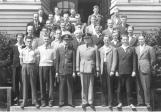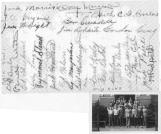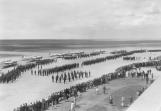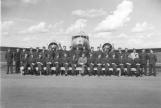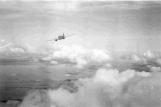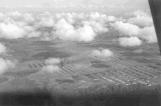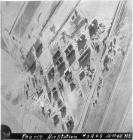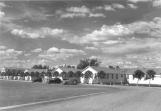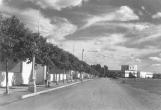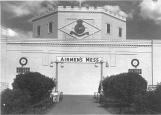1
Hume RitchieHume Ritchie, born in Grand Forks, British Columbia on November 21, 1919, was raised approximately 20 kilometers from Grand Forks in the tiny community of Cascade, where his parents operated a general store. He attended elementary school at Christina Lake and high school in Grand Forks. On April 16, 1939, a few months prior to the outbreak of World War II, at the age of nineteen, he married his wife, Nell. Their marriage would endure to the present day. (September, 2004).
Canada's declaration of war on September 10, 1939 did not come as a surprise to young Hume. His family was very patriotic and an avid supporter of the royal family. In his mind there was no question that Canada would come to Britain's aide. Nor was there any doubt that Hume would volunteer for the armed forces as "it was the expected thing to do." However, he was determined that his enlistment would be in the air force as flying had been his childhood dream. Enlisting in 1942, he took his basic training in the Alberta cities of Lethbridge, Calgary and Edmonton. He enjoyed basic training with the exception of a course in telegraphy as he found Morse code difficult to master. Despite this he passed his basic training.
In early 1944, aboard the Queen Mary, the world's largest liner, he was deployed across the Atlantic to Britain. In England he received more training and on July 19, 1944 Flight-Sergeant Ritchie flew his first mission as bomb aimer on the Lancaster bomber, LM-537. The objective was to destroy the German marshalling yards in Revigny, France, a target that was never reached. The official log states that at 0131 hour the Lancaster was downed by enemy flak! Ritchie, however, doubts that it was enemy anti-aircraft guns that downed the plane. Rather, he insists that the plane was targeted by a German fighter. He had observed the fighter and believes that the pilot maneuvered his craft to the bomber's underbelly and from that position shot it down. Earlier he had observed from his vantage point four other bombers going down ahead of theirs.
Ritchie believes that the members of his flight crew were very fortunate as four out of the seven members survived. The odds of this happening were very rare. Often all of the crew would be lost or only one or two would survive. Numbered among the dead from his crew were the pilot, the navigator, and the wireless operator.
Hume also considers himself lucky to have survived the jump from the plane. Due to the small chute used, he believes that he hit the ground at a force of twenty miles per hour and narrowly missed a barb-wire fence and a large tree. After hiding his chute he buried a "lucky" shilling at the base of the tree. The shilling had been given to him by a British pilot. Just prior to take-off this pilot had jokingly told the flight crew of LM-537 not to "bend our kite." (Crash the British Lancaster). Ritchie took exception to the insinuation his crew was in any way inferior to a British crew and he told him so. The pilot's response was to toss Ritchie a shilling while telling him to "cheer up chum. Here's luck to you." This was the shilling he buried.
Having parachuted into enemy-controlled territory Ritchie now had to do his utmost to avoid being taken prisoner by the Germans. He spent the first day hiding and avoiding human contact. On the second day Ritchie ventured to a farmhouse. Here he spoke to an elderly woman. She was terrified "fearing that he was a German soldier." When her husband appeared Ritchie showed them a "shin plaster" (twenty-five cent Canadian paper currency) and pointed to the word Canada. Immediately they took him inside, fed him and fixed their own bed for him to sleep on. Early the next morning after being fed a hearty breakfast and given a handful of large sugar cubes, Ritchie left this farmhouse and headed across the French countryside.
It was on his third day in France that Ritchie came out on a road where he encountered a sixteen year old girl riding a bicycle. This encounter would be a stroke of luck. Ritchie made himself understood that he was in the R(C)AF and that his plane had been shot down. The girl indicated that Ritchie should go with her. She was taking lunch to her sisters who were working in a field nearby. After lunch the girls took Ritchie to their farmhouse. Here Ritchie met Monsieur et Madame Boucan and the rest of the Boucan family. The Boucan's would feed, clothe, shelter and hide Ritchie for the next seven weeks.
During the early days of his stay with the Boucans, Ritchie would learn the fate of Dennett, his crew-mate and the pilot of LM-537. Shortly after Ritchie's arrival one of the Boucan sons journeyed to a neighbouring village. It was near this village that the Lancaster had crashed. The boy returned with the news of the crash as well as a glove that had been retrieved from one of the dead crew members. The glove was inscribed with the pilot's serial number. Recognizing the serial number, Ritchie knew for certain that his Australian friend was dead.
While at the house Ritchie had one particularly close call. A German soldier had come by for eggs and other farm produce. Ritchie, having no time to hide, had been caught off-guard by the appearance of this enemy soldier. He simply continued to carry on with his farm chores as if he was a family member or a hired hand. It was only after the German left that he realized that he was still wearing his air force belt with the RCAF insignia. At that point the perspiration began to flow. Not only was he concerned about his own safety but very anxious for the safety of the members of this courageous French family who were putting their own lives on the line to help him. There would be other close encounters but none as tense as this one.
With the arrival of Patton's army, the Boucan's secret would be revealed. Finally Ritchie was shown to the villagers of Don Pierre at a celebration in the village pub. Fearing that there may be one or two collaborators in their midst, the Boucans had not mentioned to anyone that they were habouring an allied airman. It was only after the liberation that they dared to make this known.
Hume Ritchie would, with the assistance of the Americans, make his way back to Britain. After a short stay in London, where he was asked to provide details to members of the Dennett family in regard to the pilot's death, he would return to Canada. The return trip was aboard the Ile de France. As coincidence would have it, he was accompanied by, Dave McKinnon, a chum from Trail. He and McKinnon had enlisted at the same time, had trained together, had gone overseas together, and had been shot down over France around the same time. Now they were returning to Canada together. Back in his beloved province, Ritchie would celebrate V-E Day in Vancouver.
Upon his discharge from the armed forces, Hume held a variety of jobs in the Vancouver area. He and his wife Nell, however, could not resist the call of the Boundary and they decided to return to Christina Lake. Soon after returning, Hume obtained a position with Canada customs. He moved to Grand Forks and made it his home. It would be in Grand Forks that he and Nell would raise their daughter Marna Ann. It would be at the Carson border crossing that he would have a productive career working for thirty-three years until his retirement in 1977. It would be on the rivers and lakes and in the forests of the Boundary that he would pursue his passions of hunting and fishing. Hume has been able to reap the benefit of his wartime sacrifice, a peaceful and fulfilled life in his most loved corner of Canada.
